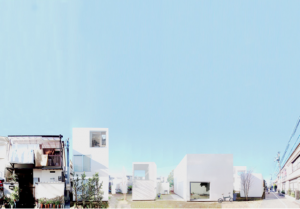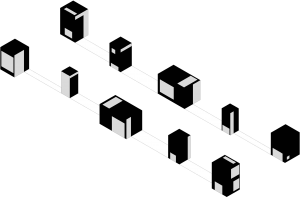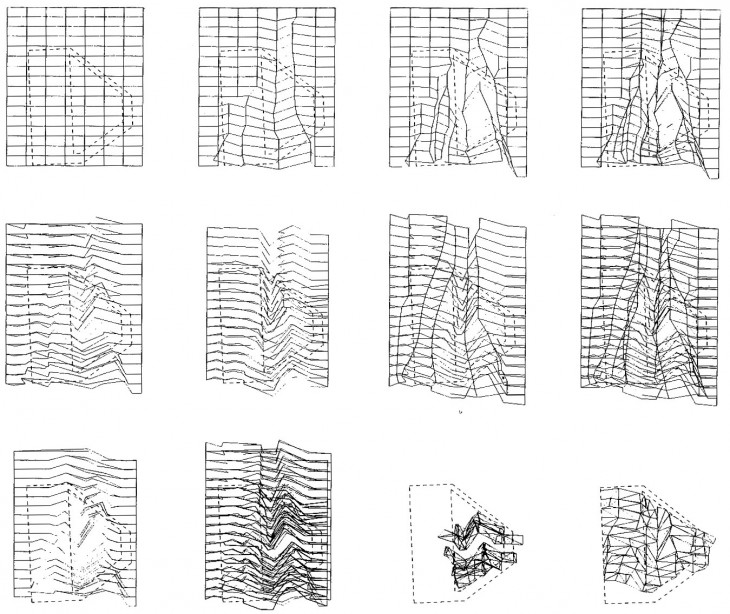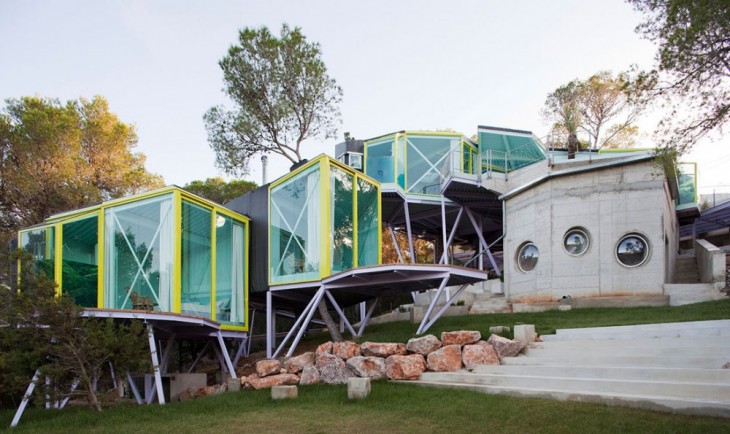Category Archives: Uncategorized
T1_WATERCUBE & ON GROWTH AND FORM
Relational Logics_Fujimoto_T6
Fujimoto (T6)
In this subliminally predictive text, Sou Fujimoto lists a series of words that relate to qualities of architectural design, with regard to the practice of architecture in the future. The author does not organize the ideas in a particular order or in specific categories. This reveals how Fujimoto expresses the intertwined connections and links between the ideas discussed, where an understanding of this can be appreciated as the text develops.
Fujimoto makes a prediction. In the future places will allow people to discover them despite the fact that topography is not a possibility in the urban framework. A factor in this envisioned future must be defined in order to allow people to seek out opportunities in urban realities. Re-humanizing urban space through a quality such as light, and exploring ways to maximize sustainability and improve livability in the city, driving awareness and interest in city dwellers, urban planners and developers.
Architectural possibilities exist in-between different places, different times of the day, different sizes and scales of environments, and different periods of motion. This idea demonstrates a merger of functional and recreational spaces in architecture.
Locale is finding opportunities in a place that has qualities that promotes desirability but is not yet prepared to inhabit in. Essentially it is a place found in natural (or urban) realities as they are, thus connecting desirability to other somethings (or nothings). These ideas fall under the umbrella of the realm of possibilities, the unspecified qualities of a promising nature that is within the scope of an architect to design and develop.
The idea that objects of spatial and temporal dimension are mutually intertwined in various relationships. Different fields of investigation come together and connect to form common ideas, yet diverging and involving themselves with other concepts, ultimately finding and establishing connections due to the exponential growth of information.
Architecture is a single space, where all things are connected and detached in a network of concepts relating to and with spatial and digital parameters. The idea that the small scale is connected to the big scale and vice versa. For example the smaller part strives to impose its ideas with the whole, and the whole is contained within the part.
The notion of how things were connected together before the divide involves deciding upon the elements that divide two qualities or more, and defining the way in which those specific elements came together before. It forces a sense of connectivity in order to offer a basic level of comfort and efficiency. Furthermore the relationship between uncertainty and lucidity co-exist, thus this notion of in-between forging ties of connection.
A tree diagram represented as a simple childlike drawing contains many regulated things. This idea of using a lot of information to create simple structures, frameworks to fit all the information in a tree like diagram. Here, common ideas introduce the notion of simplicity.
The ideas discussed above relate to connectivity, the state of being connected or interconnected. This is when two ideas are brought together to form a real link, in addition to physically providing lines of access and communication.
The sum of architectural possibilities and connectivity results in this idea of interaction, where reciprocal actions work together in such a way that two or more things have an effect on each other.
Inside and outside as an approach to creating contrasting spaces considering beauty and comfort. The definition of enclosure without having a physical barrier, yet playing with dense and concentrated environments, such as trees in a forest. It contributes, brings awareness and also creates open and closed spaces.
On top of that a house is a place for people to live. This typical object interacts with outside spaces through the use of tricks, transforming nature to connect with the city. This idea of fusing inside and outside results in the creation of in-between spaces known as gardens, verandas and intervals in architecture. These are places of scenic views and diverse environments that are manipulated by people, designers and architects primarily. This is very apparent in Japanese architecture, Fujimoto observes. Fundamentally the exterior envelope establishes the relationship between inside and outside.
Interaction is thus the practice of designing products, environments, systems and services. It is interested in form but the main focus is on behavioral traits. The synthesis and imagining of things as they might be, and what they could become in order to satisfy the needs and desires of its users, occupants.
Relational logic provides a systematic framework, where the exploration of site physical features are observed and quantified. This approach allows the establishment of links between the various features to be defined, thus leading into the stratification of proposals considering spatial (and temporal) solutions.
Personal Interest (Line of Enquiry)
A research inquiry to find lines of interaction between density and spatial notions of poverty in the struggle to diminish poverty in Luanda’s metropolis. The qualities of density refer to lack of space and too many people in a given area. Spatial compensation must be offered. This can be done by observing what an area lacks and what an area needs in order to secure the necessities of life, becoming a place of social meaning. In addition, the resources that are offered in a particular area (may) facilitate the notion of self sufficiency via architectural solutions regarding the management of local resources. Meanwhile, poverty occurs in remote rural areas and spatial poverty traps. The latter is related to marginal areas which are less favored politically, or areas which are weakly integrated into the urban environment.
RELATION LOGICS – T4
MORIYAMA HOUSE And SANFORD KWINTER
The point of interconnection is to treat everything around us as nature is a source of living skills, history and accumulated forces trying to revitalize.
The idea that there is a human being as an actor in the middle of this big stage that is the nature and time. The relationships that occur in our environment is the place in which we live.
Because the architecture incorporates the thought, actions and concerns of the natural world and specifically within the circuits of Design Architectural Moriyama House seeks to integrate or interconnect the building interior and exterior it is natural or artificial nature nature (created by man).
Alongside the building is surrounded by gardens outwards with some architectural spaces towards the sky and others on the horizon. Creating horizontal, vertical and filter visual communication between the inner world and the outer world building perforations. Today’s job to make flexible spaces like Moriyama’s proposal that each space be used independently or together and functions in a comfortable manner and can be used by different programs and architectural sectors can be selected as desired integration.
At the same time the whole assembly is composed of several separate buildings each thus Dynamic have the freedom to use all residential buildings independently without losing their privacy. These gaps loom importance, because it is structured and what communicating spaces, this city principle considered and used as part of the housing and vegetation that helps to define and communicate spaces between the house and outside.
Creating an inner world that they can enjoy various spaces and lifestyles. Generating a building adaptability and can last over time. This makes it possible to develop and experiment with new ways of understanding community housing where there are numerous Public Private contrasts Interior-Exterior and Unit-All. On the other hand it has to do with digital information, everything is connected and integrated and often talk we do parametric.
“YOU CAN SEE PARAMETRIC, FEEL AND RECEIVE, BUT IT IS NOT”
As the architecture and all the cultures that have formed and consist of experimental changes in the world and the establishment of a different order each time and all are modifiable as a form of natural knowledge.
I HAVE THE CONVICTION OF RESEARCH ON PARAMETRIC AND NON-PARAMETRIC ARCHITECTURE. MULTIPLE ORDER TO UNDERSTAND THEIR SYSTEMS AND KNOWLEDGE OF THIS SYSTEM. THEREFORE UNDERSTAND WHAT IS PARAMETRIC, YOU CAN SEE AND WHAT IS NONPARAMETRIC, WHAT YOU CAN NOT SEE .
Fujimoto _ Frohn & Rojas [Frame 2]
Peter Eisenman – Church of the Year 2000
[The] classical scripting of musical notes _ stave _ grid _ process
The reading starts with an interesting comparison of two primitive typologies of shelter. This reference to the instinctive necessity of sheltering, somehow takes the reader to the beginning – the raison d’être of the discipline of architecture. The geographical positioning, the typology, the morphology, the construction method and the organisational layout of the concept of a shelter have been progressively changing, perhaps evolving, since the existence of the human race. This primitive demand for sheltering still is present today, and will probably always be present in the future. Thanks to the reassurance of the presence of this demand, concerned individuals – in this case architects, keep on discussing, critiquing, developing and improving the various features of the past, present and future shelters. (The features being the stated geo-positioning, typo-morphology, method, layout…) The author criticises the modernist approach through a computer science simile of 0s and 1s, arguing that the perfectly functional “nests” of the modernist era as lacking the gradient between the two, in other words, the opportunity and the space for creativity and unexpected encounters, if to quote, “accidents”. While this argument adverts to a prominent issue of the recent past of our built environment, the author renders this insufficiency of the modernist model by objecting to Van der Rohe’s musical description of architecture as the staves. An image of music notes hanging in air without the staves is defended to be as – or even more, coherent (by effacing the main elements of the classical scripting of musical notes), yet rigid numeric ordering and hierarchic titling is used for the organisation of the text. Even though the (post…) post-postmodernist architecture seems to be the anarchist, it actually is the rebellious child of the previous modernists, and like every child, has had a lot to learn from the progenitors.
Although the real meaning of the word “nest” comes to mean a shelter built by birds, when correlated to the word cave, takes a “manmade” implication, where the cave is interpreted as an already existing geographical formation occupied by men. With the introduction of the word “locale” the text goes more into detail about the impact of the occupant and his objects, highlighting the opportunity of these notions to identify the space. With the phrase “manipulated nature” the author defines the garden, which could also have been an interesting “in-between” description of the previously mentioned titles of the cave and the locale. Following the reference, it is important to underline that the occupants have had manipulated the existing – the cave, in order to turn it into their locale. It does not seem correct to conceive the cave as a gift of mother nature for human beings to shelter and seek for opportunities, but more as a space for the occupant to manipulate (through objects, mural artwork, as well as preliminary constructional interior design) and create opportunities through its potentiality.
By the time most of the individuals reach the age to leave the “nest”, they tend to look for a suitable (un-)built environment to find shelter, directed by their individual wills and conditions. This search, just as stated further in the reading, can take the form of a town or a city, a neighbourhood, a street, a house, a room, a bed… Opposing to the inflexible definitions of architectural entities by the modernist – or the “ordinary”, the author gives the reader a different perspective by redefining the part/whole – house/city relationship from a scaleless point of view. The rigid boundaries of a house and a city are questioned, bringing into attention the concepts of inside out – outside in. The Wall House analysed during the previous week of the course is potentially a good example for the practice of this vision. Multiple layers of the skin providing a “delicate” passage from the interior to the exterior (alongside of their sophisticated environmental gains) creating new experiences on how to inhabit the house as well as the landscape surrounding it.
Ruins are defined as “the end” and “the simultaneous beginning” of architecture, putting forward the parameter of time. At this point, the part about the exterior envelopes and how they intercede the relationship with the physical world, brings up an absorbing question of how in the future, architecture could succeed to be the medium between our fast-growing virtual world and our indispensable physical world.
Mehmet Yilmaz Akdogan
Relational Logics – T5
The Never Never Land House situated in Cala Vadella Valley – Ibiza explores the idea of integration of built environment with existing natural environment. There are three main principles considered in designing this integration. First is the continuity of the immediate green. In order to accomplish this, tree removal is minimised on the construction site by beginning the design process with mapping of the existing trees and situating the construction on the vegetation-free area. Here, Positional Relation can be identified. Trees are regarded as vertical architectural elements and proximity of trees to the construction is highly considered. Second principle is preserving the bio/geodiversity of the valley through various means of sustainability. More than 80% of the building mass is raised on piles in favour of not causing any disturbance to the soil and species living. Also, spaces for waste filtering, water treatment, water tank, etc., are placed into a compact concrete vessel for preventing contamination of soil. This is also an example of Disturbed Relation where built elements and nature are separated explicitly, put in contrast. This continuity idea is also carried out in the third principle which involves the spatial arrangement of the house. The space is not divided according to activities which takes place in it. It rather has an open plan where private and common activities happen simultaneously. The Never Never Land House is designed as a place of freedom where nature and architecture merges and numerous actions flow into each other.
The Never Never Land House is an approach to integrate built environment with immediate natural environment. One of the main goals of the project is to not disturb the natural environment. Yet, the piles are standing on concrete blocks, and also there is a large concrete mass for water tank etc. on the ground level. In addition, materials which are used in construction are not environmentally friendly. Also, climate-which is an important concern in sustainability-is not taken into account at all. The intention of preserving the qualitative continuities of the valley is valid. However, I believe it is an approach which is taken only on the surface.
In Form & Function Follow Climate, Philippe Rahm proposes a new kind of relation for form and function in current architecture. First, the concept of sustainability and how it is interpreted often in architecture is explored. The term sustainability is first defined in late 20th century as “a development that meets the needs of the present without compromising the ability of future generations to meet their own needs”. This definition was often read poorly as “reduction of energy consumption”. Therefore architecture often produced completely sealed off buildings and turned most ecological buildings into most isolated ones. It is argued that we should break off with these preconceptions and habits. Later in the text, the two major theories on form and function is explained. In late 19th century Louis Sullivan comes up with the idea of “form follows function” where architect gives the “appropriate” form to functions. However, this statement is too univocal and rigid, as needs and functions may change in time. Following Sullivan, Louis Kahn and his contemporaries come up with “function follows form” declaration which suggests, a system rigid in terms of structure but flexible in terms of programme. What Rahm proposes is “both form and function follow climate”. He believes that we should abandon traditional approaches and create a new spatial organisation where function and form can emerge spontaneously in response to climate. Architecture, formally should not be representative and analogical. It rather should present physical, climatic, geographic, physiological spaces and times. Architecture should be independent of programme. It should be open to variation of weather conditions, day&night transitions, passage of time. He conceives that architects should work with matter of space which is density of space, intensity of light, geography, shifting climates, atmospheric qualities etc. Capacity of architecture should not be tied to function. Spaces should be open to interpretation and should be liberated from function altogether.
Form & Function Follow Climate, proposes giving freedom to the functional interpretation of space. Furthermore, it suggests that this kind of design approach can only be achieved if climate is the main and only concern. Rahm believes that if architects design with climate and matter of space, one can be able to liberate form from function and create a space independent of its function. However, climate cannot be the only matter. There are other aspects as well which architects should take into account, such as culture, ethics, habits, materiality, natural resources etc.
I would like to do a research on “material energies” that is mentioned in The Shape of Energy, Sean Lally. Personally I find it very interesting breaking off with the statics limits of the conventional materials(stone, steel or glass) and controlling electromagnetic, chemical interactions, thermodynamics etc that surrounds us for creating their own architecture. With these new set of building materials, architect who used to work with points, lines and surfaces now work with new types of boundary edges like gradients of intensities and fallout.







